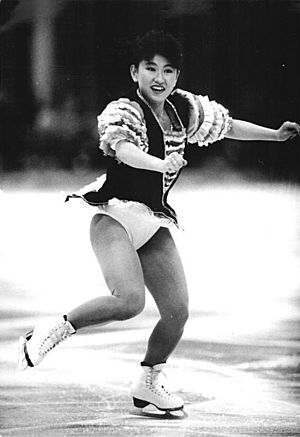Midori Ito facts for kids
Quick facts for kids Midori Ito |
|||||||||||||||||||||||||||||||||||||||||||||||||||||||||||||||||
|---|---|---|---|---|---|---|---|---|---|---|---|---|---|---|---|---|---|---|---|---|---|---|---|---|---|---|---|---|---|---|---|---|---|---|---|---|---|---|---|---|---|---|---|---|---|---|---|---|---|---|---|---|---|---|---|---|---|---|---|---|---|---|---|---|---|

Ito in 1989
|
|||||||||||||||||||||||||||||||||||||||||||||||||||||||||||||||||
| Personal information | |||||||||||||||||||||||||||||||||||||||||||||||||||||||||||||||||
| Country represented | |||||||||||||||||||||||||||||||||||||||||||||||||||||||||||||||||
| Born | 13 August 1969 Nagoya, Aichi, Japan |
||||||||||||||||||||||||||||||||||||||||||||||||||||||||||||||||
| Height | 1.45 m | ||||||||||||||||||||||||||||||||||||||||||||||||||||||||||||||||
| Retired | 1992 | ||||||||||||||||||||||||||||||||||||||||||||||||||||||||||||||||
|
Medal record
|
|||||||||||||||||||||||||||||||||||||||||||||||||||||||||||||||||
| Midori Ito | |||||
|---|---|---|---|---|---|
| Japanese name | |||||
| Kanji | 伊藤みどり | ||||
| Kana | いとう みどり | ||||
|
|||||
Midori Ito (伊藤みどり, Itō Midori, born 13 August 1969) is a famous retired figure skater from Japan. She is known for her powerful jumps and exciting performances.
Ito won the 1989 World Championships and earned a silver medal at the 1992 Winter Olympics. She made history by being the first woman ever to land a triple Axel in a competition. The triple Axel is one of the hardest jumps in figure skating.
At the 1988 Calgary Olympics, she amazed the world by landing seven triple jumps in her free skate program. Many people consider her one of the greatest figure skaters of all time.
Contents
Skating Career
Early Years
Midori Ito started skating when she was only four years old in her hometown of Nagoya. She asked Machiko Yamada to be her coach, and they worked together for her entire career. By the time she was eight, Ito could already land a triple jump. After her parents divorced when she was ten, she moved in with her coach.
In 1981, at age 11, she competed in her first big international event, the World Junior Championships. She was very small for her age, which earned her the nickname "Jumping Flea" because of her powerful jumps.
In her early competitions, Ito was amazing in the free skating part, where skaters perform their own routines with jumps and spins. However, she struggled with compulsory figures. These were patterns that skaters had to trace perfectly on the ice. Because her scores in figures were low, she often finished lower in the overall rankings, even if she won the free skate.
Becoming a Champion
Ito kept improving her skills. At the 1988 Winter Olympics in Calgary, Canada, she performed seven triple jumps in her free skate. This was more than any other skater even tried to do. She finished in 5th place.
Later that year, she finally perfected the triple Axel, a jump she had been practicing for years. She became the first woman to land it in an international competition at the 1988 NHK Trophy.
Her biggest moment came at the 1989 World Championships. She performed a perfect free skate, including her famous triple Axel. She won the gold medal, becoming the first person from Asia to win a world title in figure skating.
After the 1990 season, compulsory figures were removed from competitions. This was good news for Ito, who once said, "I will not miss them in the actual event."
Olympic Silver Medal
At the 1992 Winter Olympics in Albertville, France, everyone expected Ito to win gold. In the short program, she fell on a jump and was in fourth place.
In the free skate, she started by attempting a triple Axel but fell. However, she didn't give up. Near the end of her performance, she tried the difficult jump again and landed it perfectly. She became the first woman to land a triple Axel at the Olympics. Her amazing comeback earned her the silver medal.
After the Olympics, Ito became a professional skater and performed in ice shows. She made a brief return to competing in 1996 before retiring again.
Legacy and Later Life
Midori Ito changed women's figure skating forever. She was the first woman to perform a combination with two triple jumps and the first to land all six types of triple jumps in competition. Her high-flying jumps set a new standard for the sport.
In 1998, she was given the great honor of lighting the Olympic Cauldron at the opening ceremony of the 1998 Winter Olympics in Nagano, Japan.
Even many years after retiring, Ito still loves skating. She has competed in adult figure skating competitions and continues to share her passion for the sport.
Records and Achievements
Skating Firsts
- First woman from Asia to become a World Champion (1989).
- First woman to land a jump combination with two triple jumps (1981).
- First woman to land five different types of triple jumps in a competition (1983).
- First woman to land a triple Axel in a competition (1988).
- First woman to land all six different triple jumps in a competition (1989).
- First woman to land a triple Axel at the Olympics (1992).
Awards
- Inducted into the World Figure Skating Hall of Fame in 2003.
Competition Results
| International | ||||||||||||||
|---|---|---|---|---|---|---|---|---|---|---|---|---|---|---|
| Event | 81–82 | 82–83 | 83–84 | 84–85 | 85–86 | 86–87 | 87–88 | 88–89 | 89–90 | 90–91 | 91–92 | 95–96 | ||
| Olympics | 5th | 2nd | ||||||||||||
| Worlds | 7th | 11th | 8th | 6th | 1st | 2nd | 4th | 7th | ||||||
| Skate America | 2nd | 2nd | ||||||||||||
| Skate Canada | 1st | |||||||||||||
| NHK Trophy | 1st | 1st | 2nd | 2nd | 1st | 1st | 1st | 1st | ||||||
| International: Junior | ||||||||||||||
| Junior Worlds | 6th | 3rd | ||||||||||||
| National | ||||||||||||||
| Japan Champ. | 2nd | 1st | 1st | 1st | 1st | 1st | 1st | 1st | 1st | 1st | ||||
See also
 In Spanish: Midori Itō para niños
In Spanish: Midori Itō para niños


